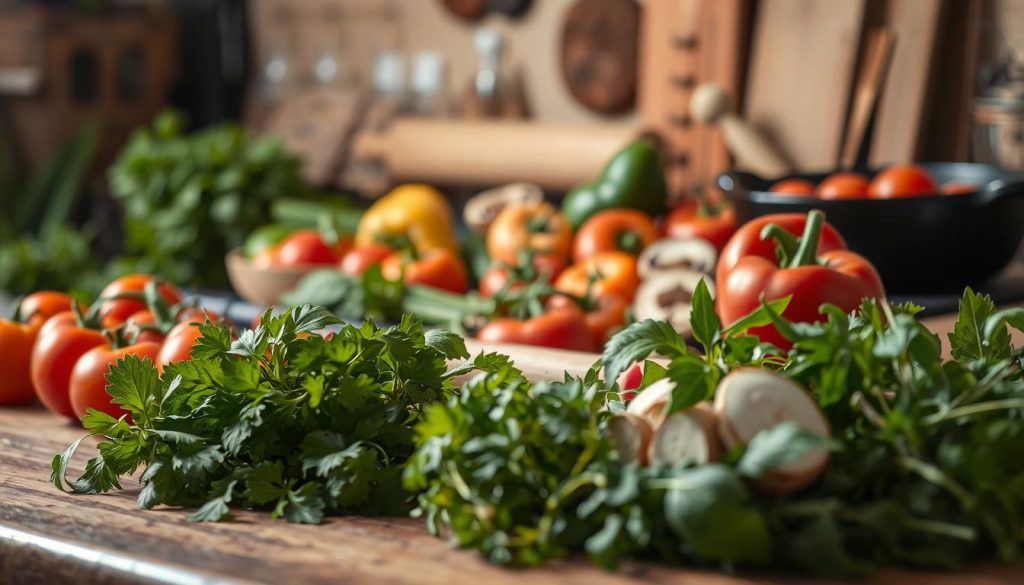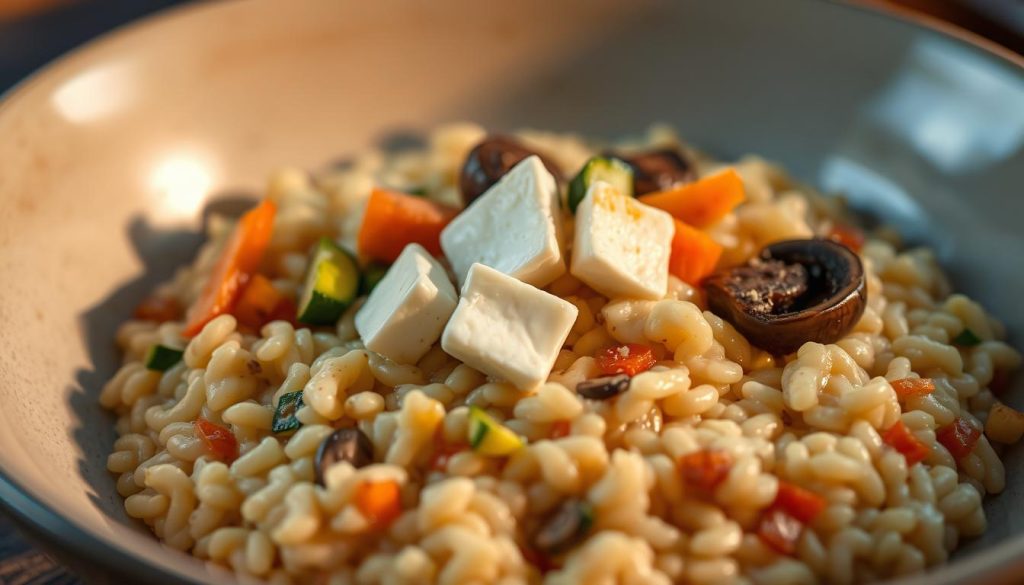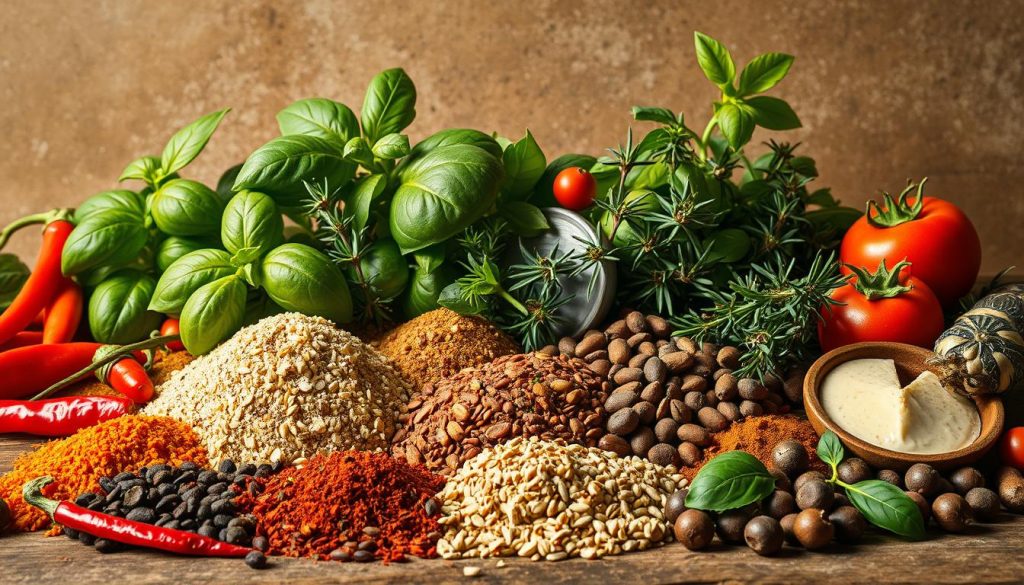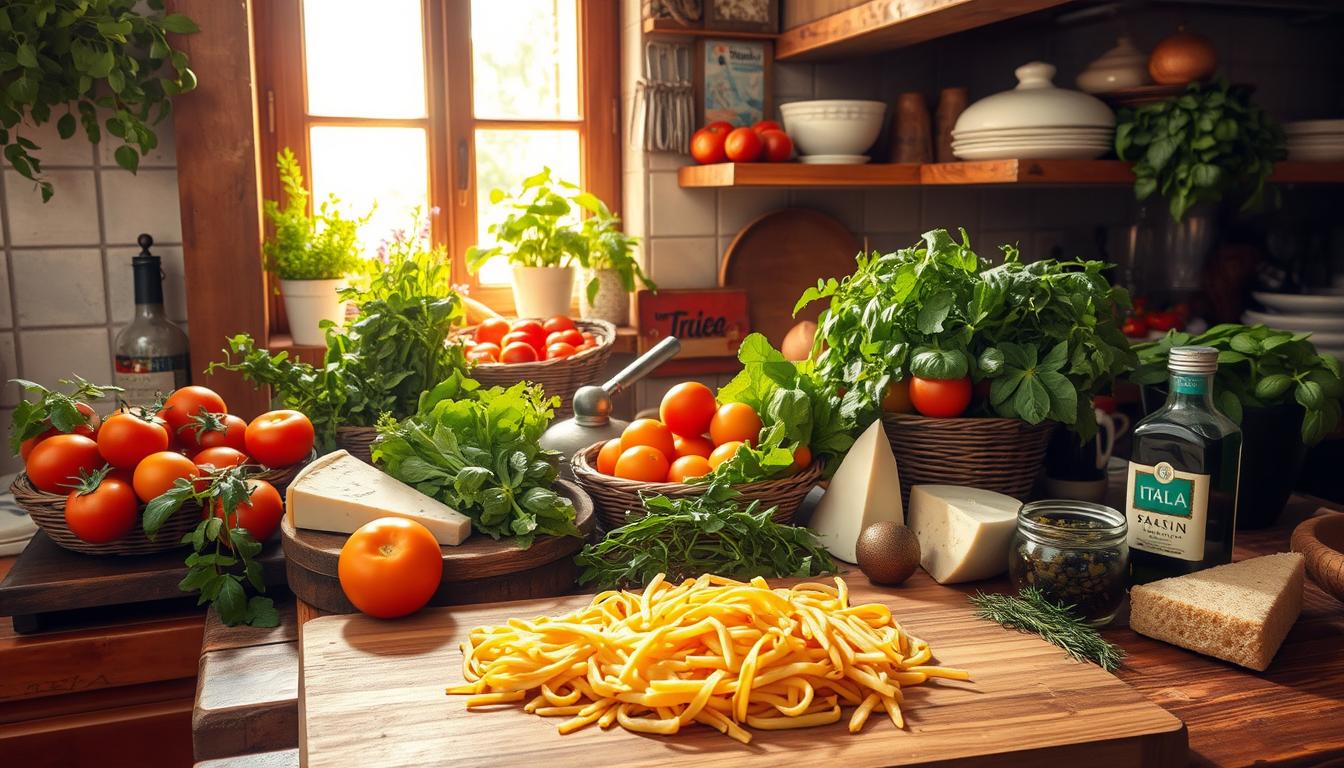We’re excited to explore authentic Italian recipes that highlight Poland’s rich flavours. By mixing traditional Italian cooking with Polish ingredients, we can make special dishes. This guide aims to inspire us to mix Polish ingredients with Italian cooking methods.
Our goal is to make our kitchens a place of creativity and tradition. We’ll learn to add a personal touch to classic recipes. This way, each dish will celebrate Italian traditions while also showing off the freshness of Polish ingredients.
Introduction to Authentic Italian Cuisine
Italian cuisine is a treasure trove of Italy’s rich culture. It’s all about using top-quality, fresh ingredients and old cooking methods. These recipes have been passed down through generations, each with its own story and taste.
Authentic Italian cooking is all about keeping it simple and using what’s in season. Different parts of Italy use different ingredients and cooking styles. For example, the North loves cream and butter, while the South is all about olive oil, tomatoes, and seafood. This variety lets us discover new tastes and create our own dishes.
Learning about these traditions helps us make delicious Italian food. By using local ingredients and tweaking family recipes, we celebrate Italian cuisine and the fresh produce around us.
The Importance of Local Ingredients
Using local ingredients is key to making authentic Italian dishes. Fresh produce brings out the best flavours and adds important nutrients. This makes our meals not only tasty but also healthy.
Choosing local ingredients also helps the planet. It cuts down on carbon emissions by reducing food travel. Supporting local farmers strengthens our community and respects the environment.
Local ingredients give our dishes a special touch. They capture the essence of the region, blending Italian traditions with local flair. This makes our meals truly unique and meaningful.
Exploring Polish Ingredients for Italian Recipes
Using Polish ingredients in Italian recipes is a great way to mix flavours. Hearty potatoes are perfect for many dishes. Beetroot adds colour and a rich flavour, making Italian food even better.
Polish cheeses like oscypek and twaróg make pasta sauces and risottos creamy. They add a special touch to our meals. Vegetables like cabbage and carrots can be used as toppings or in soups. They bring freshness and texture to our dishes.
Exploring Polish ingredients lets us celebrate local produce and get creative. By adding these unique flavours to our Italian recipes, we create dishes that are both traditional and exciting. Each meal becomes a special blend of culinary traditions.

Authentic Italian Recipes with Locally Sourced Ingredients
Creating authentic Italian recipes with local ingredients is a journey we cherish. Sourcing ingredients in Poland adds immense value. Fresh produce boosts our dish flavours and supports local farmers.
In Polish markets and shops, we find a variety of vegetables, cheeses, and meats. These items reflect the heart of the culinary scene.
Finding the Right Ingredients in Poland
Exploring local markets lets us connect with farmers and learn about their produce. Some top places to visit include:
- Local farmers’ markets: Perfect for fresh veggies and organic produce.
- Specialty shops: Find unique cheeses like oscypek to enhance our recipes.
- Grocery stores: Look for locally sourced meats to replace traditional Italian ones.
Combining Italian Traditions with Polish Flavours
Mixing Polish elements into our Italian recipes creates a wonderful flavour fusion. We can try:
- Using Polish herbs like dill and marjoram in classic sauces.
- Adding local grains to pasta dishes for texture and nutrition.
- Making pizzas with local toppings for a unique twist on an Italian favourite.
By doing this, our dishes honour Italian traditions while celebrating Poland’s rich flavours.
Classic Italian Pasta Dishes with a Local Twist
We mix traditional Italian pasta with Polish grains to create something special. Using spelt, rye, and other Polish grains, we make pasta that’s both Italian and Polish. This way, we can make pasta dishes that are both tasty and honour Poland’s farming traditions.
Utilising Polish Grains for Homemade Pasta
Making pasta with Polish grains is fun and rewarding. Spelt adds a nutty taste, and rye gives it a special texture. Here’s how to make fresh pasta:
- Start with 200g of spelt flour and 2 large eggs to make the dough.
- Knead the dough for about 10 minutes until it’s smooth.
- Roll it out thinly and cut it into shapes you like.
- Let the pasta dry a bit before cooking it.
This method makes our pasta dishes hearty and full of flavour, thanks to these grains.
Locally Inspired Sauces and Seasonings
To go with our homemade pasta, we make sauces that celebrate Poland’s tastes. Here are some ideas:
- A fresh tomato sauce with Polish tomatoes, basil, and garlic.
- A creamy sauce with Polish cheeses and seasonal greens like kale and spinach.
- A spicy sauce with Polish chillies and Italian herbs for extra depth.
These sauces make our pasta dishes even better, blending Polish and Italian flavours. By using local ingredients, we get to enjoy a unique taste experience at home.
Italian Risotto: A Fusion of Local Produce
Risotto is a beloved dish in Italy, known for its creamy texture. By adding local Polish vegetables, we can give it a new twist. This mix of fresh, seasonal produce makes the risotto even richer and celebrates our region’s flavours.
Choosing the Best Local Vegetables for Risotto
Choosing the right vegetables is key for a great risotto. In Poland, we have many excellent options:
- Asparagus adds a delicate green note.
- Mushrooms bring an earthy depth of flavour.
- Root vegetables like carrots and parsnips offer sweetness and texture.
Using these local vegetables makes the risotto even better. It connects us to the flavours around us, blending Italian and Polish cooking styles.
Enhancing Flavour Profiles with Polish Cheeses
To make our risotto even more special, we add Polish cheeses. Cheeses like Oscypek or Bryndza add a tangy taste. They also make the dish richer and more textured.
By mixing local vegetables with Polish cheeses, we honour Italian traditions. Yet, we also celebrate the tasty offerings of our local area.

Traditional Italian Pizza Reinvented
Making an authentic Italian pizza is more than just toppings. The pizza dough is key. Using Polish flour gives this classic a unique twist, improving its texture and taste. We’ll look at the best flours and share a simple dough recipe to get it right.
Making Pizza Dough with Polish Flour
Polish flour is high in protein, perfect for a strong pizza dough. We can try different flours like type 550 and type 750. Each has its own effect on the pizza. Here’s a simple recipe for a great pizza dough:
- Combine 500 grams of Polish flour, 325 millilitres of warm water, 10 grams of salt, and 5 grams of yeast in a bowl.
- Knead the mix for about 10 minutes until it’s smooth and elastic.
- Let it rise in a warm place for 1-2 hours, or until it doubles in size.
- After rising, shape the dough into a pizza base, ready for toppings.
Exploring toppings can lead to tasty combinations, inspired by Polish traditions. We might add seasonal veggies or local cheeses. This mix of Italian and Polish flavours is a unique twist on a classic.
| Flour Type | Protein Content | Texture | Best For |
|---|---|---|---|
| Type 550 | 11.5% – 12% | Soft and elastic | Thin crust pizza |
| Type 750 | 12% – 13% | Chewy and robust | Thick crust pizza |
Using Polish flour not only improves the dough but also adds a local touch to the Italian dish. Let’s enjoy making pizzas that blend Italian roots with Polish ingredients, creating a new story.
Seafood Recipes Inspired by the Polish Coast
The Polish coast is famous for its wide variety of seafood. This gives us many chances to create tasty meals. We can mix local fish dishes with Italian cooking to make our dishes special.
We’ll look at the amazing fish and shellfish from the coast. We’ll also learn how to cook them in a true Italian way.
Local Fish and Shellfish Variations
Exploring seafood recipes means looking at what the Polish coast offers. The area has many local fish and shellfish, each with its own taste and texture. Here are some of our top picks:
- Cod – A versatile fish perfect for baking or frying, bringing a mild flavour that pairs wonderfully with Italian herbs.
- Herring – Popular in Polish cuisine, this fish can be enjoyed pickled or grilled, delivering a robust taste reminiscent of the sea.
- Mussels – Often found in coastal waters, mussels are ideal for creating hearty stews inspired by Italian recipes.
- Prawns – These shellfish can elevate any dish with their sweet, tender meat, ideal for pasta or risotto.
By choosing local seafood, we support freshness and sustainability. Using seasonal seafood makes our dishes better. It also lets us enjoy the best of the Polish coast.
By mixing local fish with Italian cooking, we start a culinary adventure. This adventure brings together two lively cultures, making our meals unforgettable.
Italian Desserts Using Polish Ingredients
We start a fun journey into Italian desserts, mixing classic recipes with Polish ingredients. Italian sweets are loved by many. Adding local produce makes these sweets even better.
Poland has amazing dairy products like mascarpone and ricotta. These can be added to Italian treats like tiramisu and cannoli. They make the desserts taste richer and creamier.
Seasonal fruits like plums and apples are also key. They add sweetness and a bit of tartness. This makes desserts like fruit tarts or panna cotta even more special.
By mixing Italian and Polish flavours, we can create something new and exciting. Using local honey or Polish spices can give old favourites a fresh twist. This way, we can enjoy Italian desserts with a Polish touch.

Health Benefits of Using Local Ingredients
Using local produce is great for our health. It means we get the freshest food, full of nutrients. This way, our meals are not only tasty but also healthier.
Choosing local foods helps us feel better overall. They are fresher and taste better because they travel less. This makes seasonal fruits and veggies a joy to eat.
Supporting local farmers helps our community and the planet. It keeps our food miles low and boosts our local economy. Eating mostly local food is good for us and the environment.
Connecting with Local Farmers and Markets
Connecting with local farmers adds a special touch to our cooking. By supporting local farms, we get fresh, seasonal food that makes our meals better. Visiting farmers’ markets lets us meet the people who grow our food, building trust and understanding.
To find great farmers’ markets, we can look at local listings and community boards. These places often have many local farmers ready to share their produce. When we’re there, look for stalls that are bright and full of fresh food. Talking to farmers can also teach us about their sustainable farming methods.
Using local produce in our cooking does more than just make our food taste better. It also helps our community by supporting local businesses and farming. This connection makes our cooking a way to bring people together, enjoying the unique tastes of our area.
Creating Authentic Flavour Profiles at Home
Making real flavour profiles at home lets us bring Italy’s taste to our kitchens. We do this by using spices and herbs from nearby. This way, we make our dishes fresh and full of life.
It also helps local farmers and makes our meals more enjoyable.
Spices and Herbs: Sourcing Local Alternatives
For authentic Italian dishes, local spices and herbs are key. Fresh basil, oregano, and parsley are great substitutes. They keep the dish’s essence while adding a new twist.
Polish garlic, with its strong taste, is a wonderful choice. Using local ingredients lets us try new and exciting flavour combinations. It’s a mix of Italian traditions and our local treasures.

How to Host an Italian Dinner Party with Polish Flair
Hosting a dinner party that mixes Italian and Polish flavours is a great way to celebrate food diversity. To make the atmosphere welcoming, we can use warm lighting, set the table beautifully, and play Italian music softly. These touches will make the evening special for our guests.
When planning the menu, we can mix dishes from both cultures. Starters could be Italian antipasti with Polish zurek or oscypek cheese. The main course might be pasta with a Polish sauce and local veggies. For dessert, try an Italian tiramisu with a Polish twist, like a splash of local fruit liqueur.
Here’s a suggested menu to inspire our dinner party planning:
| Course | Italian Dish | Polish Twist |
|---|---|---|
| Starter | Bruschetta with Tomato and Basil | Bruschetta with Polish Pickles and Cheese |
| Main Course | Fettuccine Alfredo | Pasta with Sauerkraut and Polish Sausages |
| Dessert | Tiramisu | Tiramisu with Raspberry Liqueur |
By mixing Italian and Polish dishes, we can create a memorable dinner. This blend of flavours lets us celebrate the diversity in our local food scene.
Community Engagement through Cooking
Cooking is a powerful way to connect cultures and build community. It brings people together through cooking classes and workshops. Here, we share recipes and stories, making new friends and deepening our love for food.
Joining local cooking classes lets us try new tastes and learn about different traditions. Chefs and home cooks team up, celebrating our diverse food heritage. This mix of skills and knowledge helps us see food’s power to unite us.
Sharing meals can create lasting friendships. Workshops on traditional or modern cooking inspire creativity and togetherness. Cooking shows us that food is more than just food; it’s a way to connect on a personal and cultural level.
| Activity | Description | Benefits |
|---|---|---|
| Cooking Classes | Hands-on sessions teaching various cuisines | Promotes skill development and cultural exchange |
| Community Workshops | Collaborative cooking events with local chefs | Encourages teamwork and social interaction |
| Shared Meal Events | Gatherings where participants bring dishes to share | Strengthens community bonds and promotes inclusivity |
Bringing Italian Culture to Poland
Food is a powerful way to share Italian culture in Poland. By using authentic Italian recipes and Polish ingredients, we create a special cultural exchange. This mix not only supports local farmers but also brings together flavours from both cultures.
It’s not just about cooking when we celebrate Italian culture in Poland. We come together, sharing meals that blend Italian traditions with Polish touches. This way, we start conversations about our different backgrounds. Food becomes a way to learn from each other.
Our cooking adventures make our kitchens richer and help us understand cultural exchange better. By bringing Italian culture into our daily lives in Poland, we build a bridge between our communities. We get to enjoy the best of both worlds and create lasting memories together.







